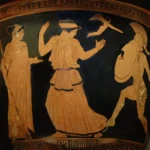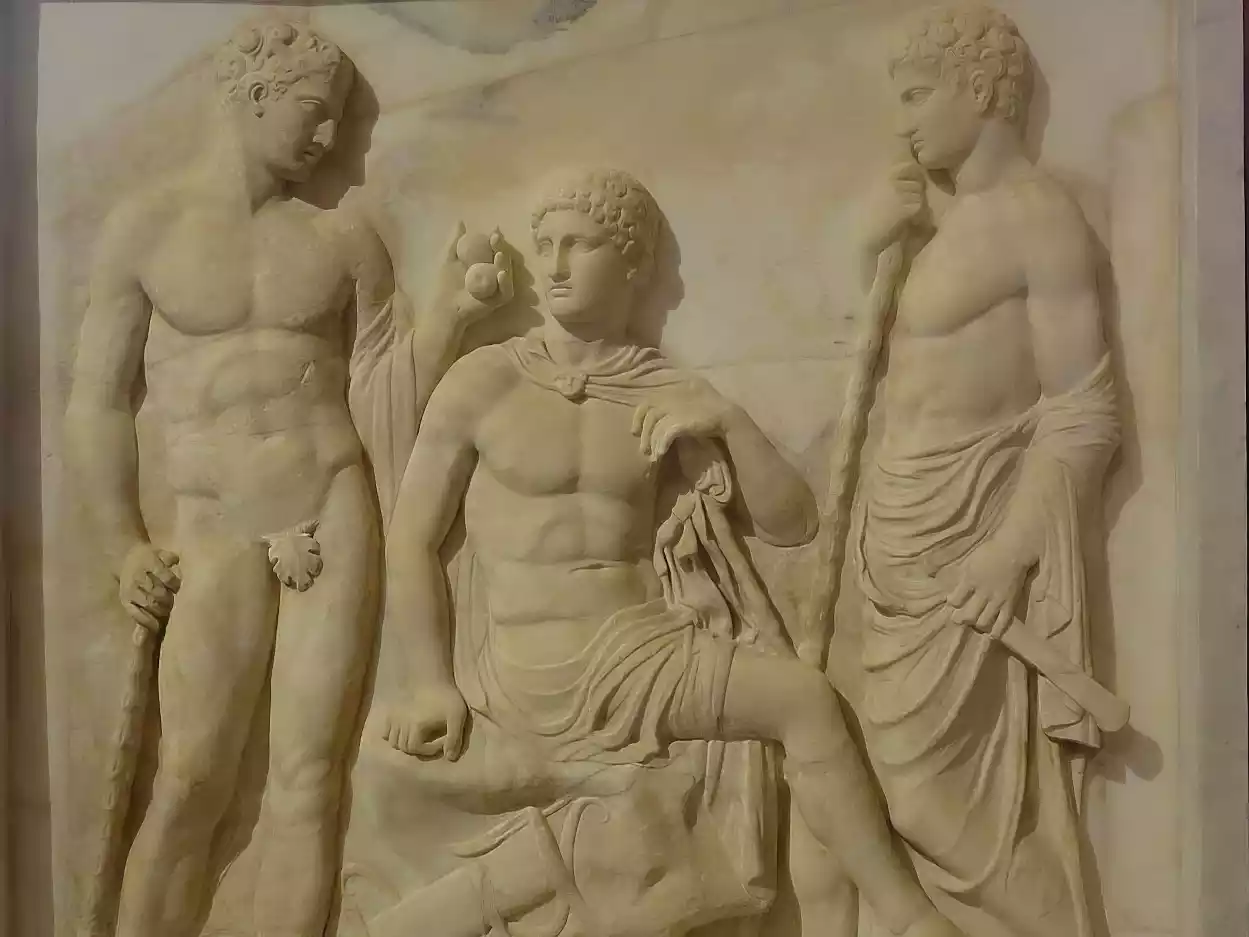
Roman relief from the Torlonia collection depicting Heracles with his characteristic club freeing his companions Theseus and Pirithous from Hades.
In the rich lands of ancient Thessaly, between the imposing mountain masses of Olympus and Pindus, one of the most important myths of Greek tradition developed. The protagonist in this narrative was Pirithous, the legendary king of the Lapiths, a tribe that inhabited the valleys of northern Thessaly. Son of Zeus and Dia, wife of Ixion, Pirithous bore divine blood in his veins that endowed him with exceptional strength and daring. His reign remained indelible in the history of Greek mythology, not only for his achievements but also for his legendary friendship with the hero Theseus, king of Athens. The Lapiths, led by Pirithous, became known for their conflict with the Centaurs, a confrontation that was captured as an allegory of the struggle between civilization and barbarism. The marriage of Pirithous to Hippodamia set the stage for one of the most famous conflicts in mythology, a bloody battle known as the Centauromachy, depicted in countless works of art from antiquity. The life of Pirithous offers us a fascinating insight into how the ancient Greeks perceived the concepts of heroic virtue, friendship, and the consequences of hubris.

Relief metope IV from the south side of the Parthenon, depicting a scene from the wedding of Pirithous and the subsequent Centauromachy. The heads of the figures were transferred to Denmark.
The Origin and Early Years of Pirithous
The Divine Birth: Son of Zeus and Dia
Mythological tradition attributes divine origin to Pirithous, as he is considered the son of the supreme god of Olympus, Zeus, and Dia, wife of Ixion. Stephen Fry in his modern study mentions: “King of the Lapiths Pirithous was the son of Zeus and Dia. Dia was the wife of Ixion. It seems hypocritical of Zeus to bind Ixion to a wheel because the latter had attempted to seduce Hera” (Fry). This observation highlights the irony and complexity of relationships in Greek mythology, where gods often exhibited behaviors they themselves punished in mortals. (Search for more information with the word: Zeus erotic encounters mythology)
Thessaly and the Lapiths: The Kingdom of Pirithous
The Lapiths were one of the oldest peoples of Thessaly, mainly inhabiting the areas around the Peneus River and the foothills of Mount Pelion. This tribe, according to tradition, was founded by Lapithes, son of Apollo and the nymph Stilbe. Thessaly, with its fertile plains and rich livestock, became a meeting point for various mythical tribes, with the Lapiths emerging as the dominant force in the region under the leadership of Pirithous.
The Ascension to Power and the First Heroic Deeds
Pirithous ascended to the throne of the Lapiths at a young age, demonstrating early on exceptional leadership skills and military intelligence. His first acts as king were characterized by the desire to establish the dominance of the Lapiths in the region and to ensure peace in his kingdom. However, the proximity to the Centaurs, a tribe of mythical creatures with the body of a horse and the torso of a human, created tensions over territorial claims.
The Hero’s Youthful Achievements
Before the famous Centauromachy, Pirithous had already gained fame for various achievements. He participated in the hunt for the Calydonian Boar and other heroic missions that enhanced his prestige among the rulers of his time. His daring and bravery were such that they earned the admiration even of Theseus, the legendary king of Athens, with whom he would later intertwine his fate.
Relations with Neighboring Peoples
Pirithous’ diplomatic ability is also evident from the relationships he cultivated with neighboring peoples. Despite initial tensions, he managed to forge alliances with several tribes of Thessaly, thus strengthening the position of the Lapiths. The invitation of the Centaurs to his wedding with Hippodamia was part of this diplomatic policy, an attempt at reconciliation that, however, resulted in one of the most famous conflicts in Greek mythology.
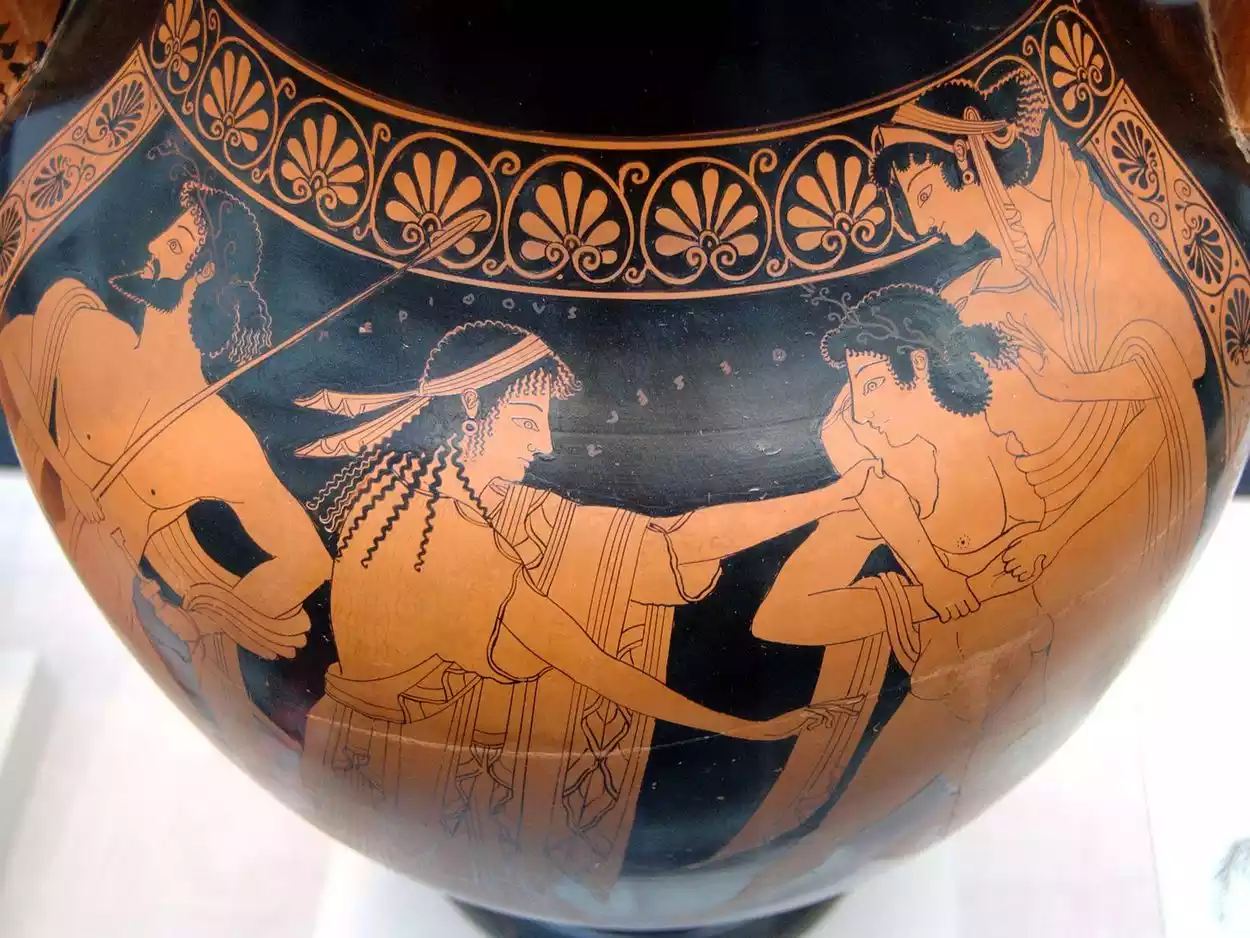
The abduction of young Helen by Theseus, with Pirithous on the left. This is side A of an Attic red-figure amphora, the work of Euthymides, dating around 510 BC. Origin: Vulci. State Archaeological Collections of Munich, no. 2309.
The Marriage to Hippodamia and the Centauromachy
The Wedding Preparations and the Invitation of the Centaurs
The marriage of Pirithous to Hippodamia was a significant event in the mythological tradition of ancient Thessaly, with dimensions that exceeded the simple ritual union. Giorgos N. Mitsopoulos in his dictionary of proverbial language points out that the “king Pirithous married his daughter Hippodamia, and among the many he had invited to the feast were the neighboring Centaurs” (Mitsopoulos). The invitation of the Centaurs to the wedding feast was a move of diplomatic significance, as the relations between the two tribes were characterized by intense rivalry due to territorial differences. (Search for more information with the word: wedding customs ancient Greece)
The Outbreak of Violence: Causes and Triggers of the Conflict
Pirithous’ peaceful intention was overturned when the Centaurs, drunk with wine, lost control. What began as a festive gathering turned into a battlefield. Modern studies mention that “the Centaurs were the main aggressors: they started the conflict with the Lapiths over the lands that both had inherited from their father Ixion, and eventually chased the Lapiths” (Hawes). This analysis suggests that the conflict had deeper roots in territorial claims concerning hereditary rights from the common ancestor of the two tribes, Ixion.
The Battle and the Victory of the Lapiths: Symbolisms and Interpretations
The Centauromachy evolved into a bloody conflict, where the Lapiths, under the leadership of Pirithous, eventually managed to prevail by demonstrating exceptional martial skill. In German sources, the scene is described vividly: “Pirithous, the king of the Lapiths, was celebrating his marriage to Hippodamia, and among the guests were the Centaurs and the Perrhaebians. The silver cups were already circulating filled with sweet-smelling wine; the Centaurs burst out with wild…” (Aeschylus). This particular reference gives us a lively picture of the prevailing atmosphere, with the silver cups filled with sweet wine and the Centaurs bursting out wildly.
The Cultural Extensions of the Myth
The confrontation between the Lapiths and Centaurs transcends the simple narrative of a conflict and acquires deeper symbolisms in Greek thought. It represents the eternal struggle between civilization and barbarism, reason and instinct, measure and excess. The Lapiths, as a human race, symbolize the organized society that operates with rules, while the Centaurs, with their dual nature, embody the uncontrolled forces of nature and passions.
The Depiction of the Centauromachy in Art
This conflict inspired countless works of art in antiquity. The Centauromachy is depicted on the metopes of the Parthenon, in vase paintings, reliefs, and frescoes, demonstrating the significance of the myth in Greek consciousness. The depiction of Pirithous in these works usually presents him as a brave warrior and wise leader who guides his people to victory, reinforcing the archetype of the ideal leader who combines strength with prudence.
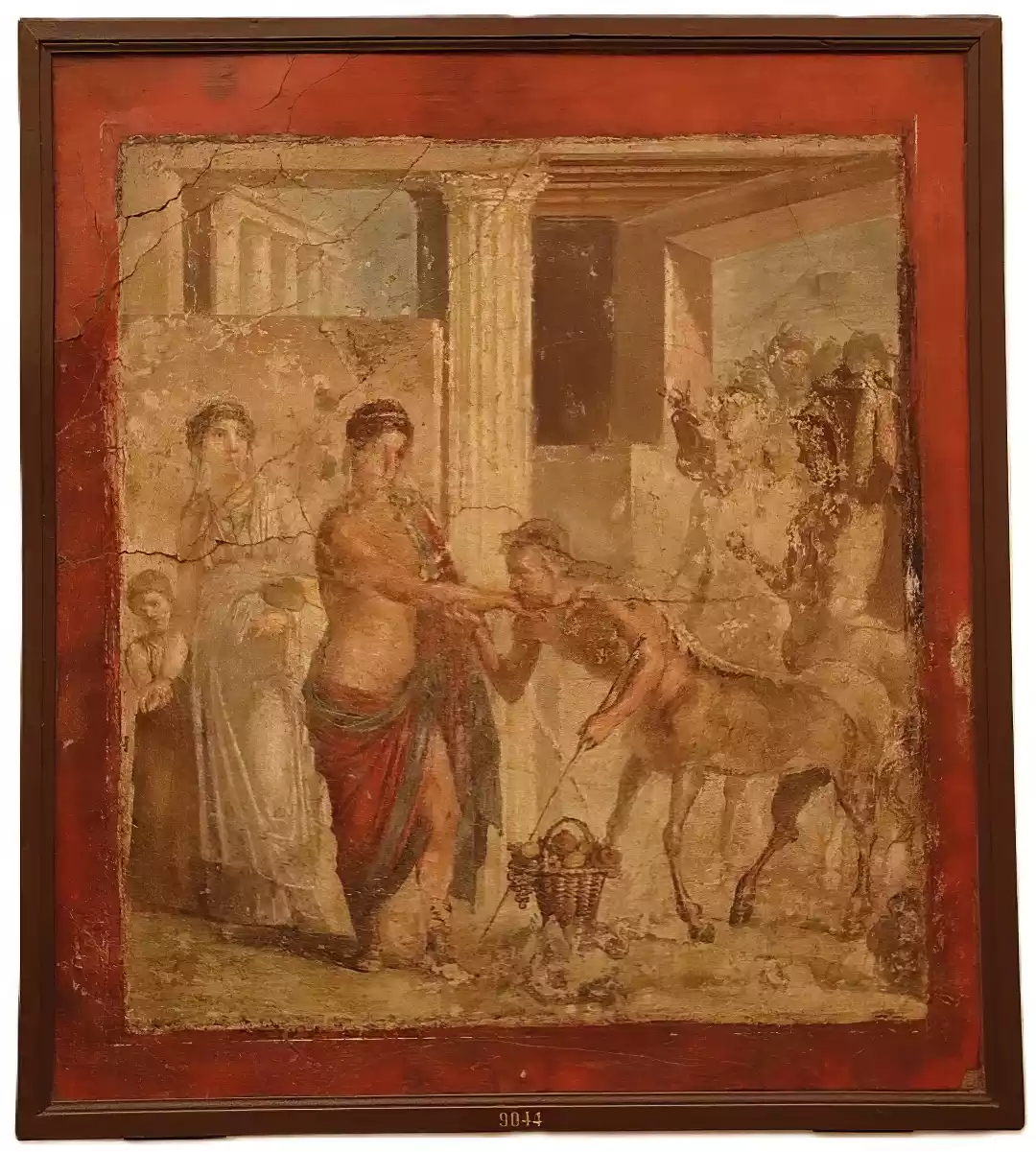
Fresco depicting Pirithous welcoming the Centaurs at his wedding, foreshadowing the upcoming conflict of the Centauromachy. It comes from the house of Marcus Gavius Rufus in Pompeii. Naples Archaeological Museum.
Pirithous and Theseus: A Historic Friendship
The Meeting of the Two Heroes and the Forging of Their Friendship
The meeting of Pirithous with Theseus is one of the most characteristic examples of heroic friendship in Greek mythology. The two rulers, although initially met under conditions of rivalry, quickly recognized in each other the virtues they themselves valued — bravery, intelligence, and a sense of justice. This mutual appreciation turned into a deep friendship that was to decisively influence the course of both. The respect between the two men was such that Theseus responded immediately to Pirithous’ call during the Centauromachy, contributing decisively to the victory of the Lapiths (Decharme).
Common Ventures and Adventures
The friendship of the two heroes was forged through common adventures and dangerous undertakings. One of their most famous joint ventures was the abduction of Helen from Sparta when she was still a young girl. Pirithous supported Theseus in this endeavor, and in turn, Theseus vowed to help his friend in his next venture. This commitment, indicative of the value the ancient Greeks placed on the oath of friendship, ultimately led the two heroes to their most daring and fateful venture. (Search for more information with the word: friendship heroes ancient Greece)
The Descent into Hades and the Tragic End of Pirithous
The last and most ambitious venture of the two friends was their descent into the Underworld, with the aim of abducting Persephone, the wife of Hades. Pirithous, after the death of Hippodamia, driven by arrogance and insurmountable hubris, desired to marry a goddess, and chose the very queen of the Underworld. Theseus, faithful to his oath, followed him despite his objections. The outcome of this daring mission was tragic for Pirithous: he was trapped forever in Hades, bound to a throne of oblivion, while Theseus eventually managed to be rescued thanks to the intervention of Heracles. This myth serves as a didactic narrative about the limits of human ambition and the consequences of hubris against the gods.
Different Interpretations & Critical Assessment
The myth of Pirithous and the Lapiths has been the subject of different interpretative approaches by scholars of Greek mythology. Some researchers, like Walter Burkert, identify in the Centauromachy the allegorical depiction of the conflict between civilization and primitive nature. Others, like Jean-Pierre Vernant, approach the myth through the lens of social anthropology, highlighting the symbolic confrontation between the rules of the symposium and debauchery. Claude Lévi-Strauss and the structuralists trace deeper dualisms and oppositions, while contemporary feminist criticism, with representatives like Sarah Pomeroy, focuses on the gender dimension of the battle and the abduction of Hippodamia as an expression of the patriarchal structures of ancient Greek society.
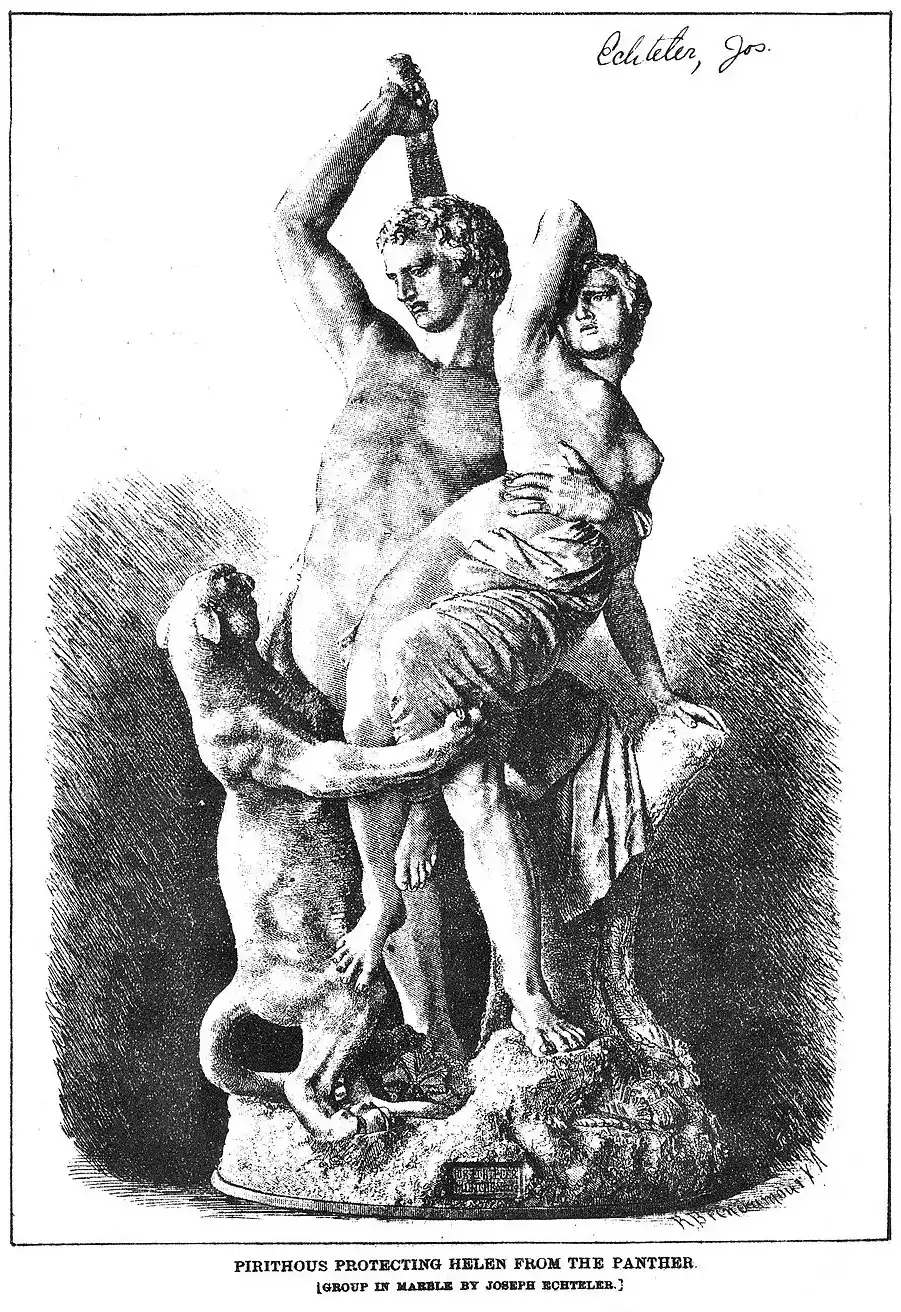
Woodcut by Richard Brend’amour (1831-1915) depicting the colossal sculpture “The Struggle of Pirithous for Helen” by German sculptor Joseph Echteler, featuring the mythological hero protecting Helen from an attacking panther.
Epilogue
The story of Pirithous, the king of the Lapiths, is a fascinating chapter of Greek mythology that continues to captivate and teach us even today. Through his journey, we follow the rise of a charismatic leader, his struggles to protect his people, and the tragic end of a life marked by hubris. The case of Pirithous reminds us of the delicate balance between heroism and arrogance, between courage and recklessness. His friendship with Theseus remains a model of devotion, while the Centauromachy continues to inspire artists and thinkers as a symbol of the eternal struggle of civilization against barbarism and chaos.
Frequently Asked Questions
What was the origin of Pirithous, king of the Lapiths?
Pirithous, according to Greek mythology, was the son of Zeus and Dia, wife of Ixion. This divine origin endowed him with exceptional abilities and strength. He reigned in Thessaly, where the tribe of the Lapiths, one of the oldest peoples of the region, dominated.
How did the famous Centauromachy start at the wedding of King Pirithous?
The Centauromachy broke out during the wedding feast of Pirithous with Hippodamia. The Centaurs, who had been invited as neighbors and relatives, drunk with wine, attempted to abduct the bride and other women of the Lapiths. This sparked a bloody conflict that ended with the victory of the Lapiths.
What was the relationship of King Pirithous of the Lapiths with Theseus?
Pirithous and Theseus developed one of the most legendary friendships in Greek mythology. Despite their initial rivalry, they formed a strong bond based on mutual respect and appreciation of each other’s virtues. This friendship led them to many joint adventures, including the abduction of Helen and the descent into Hades.
Why did Pirithous, leader of the Lapiths, decide to descend into the Underworld?
After the death of his wife Hippodamia, Pirithous, driven by arrogance and excessive self-confidence, decided to claim Persephone, the queen of the Underworld, as his wife. This act of hubris led to his tragic end, as he was trapped forever in Hades.
How is Pirithous and the battle of the Lapiths depicted in ancient art?
King Pirithous and the Centauromachy were popular themes in ancient Greek art. They are depicted in significant works such as the metopes of the Parthenon, in vase paintings, and reliefs. Pirithous is usually presented as a brave warrior leading the Lapiths against the Centaurs, symbolizing the victory of civilization over barbarism.
Bibliography
- Fry, Stephen. Heroes. 2023. Stephen Fry.
- Mētsopulos, Giōrgos N. Lexiko parimiakou logou: Ρечник на пословичния език. 1999. Mētsopulos.
- Decharme, Paul. Mythology of Ancient Greece. 2015. Decharme.
- Hawes, Greta. Myths on the Map: The Storied Landscapes of Ancient Greece. 2017. Hawes.
- Sechi Mestica, Giuseppina. Diccionario Akal de mitología universal. 1998. Sechi Mestica.
- Aeschylus, David Grene, Richmond Lattimore. Aeschylus, Vol. 1. 1868. Aeschylus.

